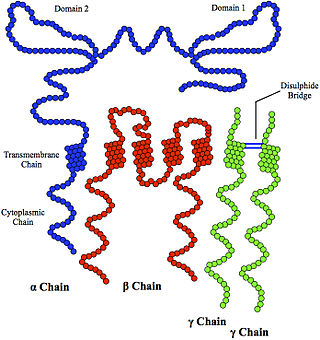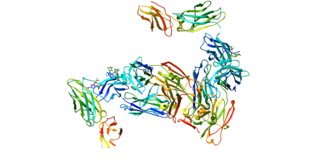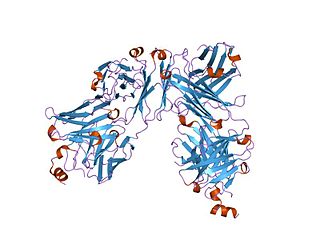
Immunoglobulin E (IgE) is a type of antibody that has been found only in mammals. IgE is synthesised by plasma cells. Monomers of IgE consist of two heavy chains and two light chains, with the ε chain containing four Ig-like constant domains (Cε1–Cε4). IgE is thought to be an important part of the immune response against infection by certain parasitic worms, including Schistosoma mansoni, Trichinella spiralis, and Fasciola hepatica. IgE is also utilized during immune defense against certain protozoan parasites such as Plasmodium falciparum. IgE may have evolved as a defense to protect against venoms.

CD23, also known as Fc epsilon RII, or FcεRII, is the "low-affinity" receptor for IgE, an antibody isotype involved in allergy and resistance to parasites, and is important in regulation of IgE levels. Unlike many of the antibody receptors, CD23 is a C-type lectin. It is found on mature B cells, activated macrophages, eosinophils, follicular dendritic cells, and platelets.

In immunology, an Fc receptor is a protein found on the surface of certain cells – including, among others, B lymphocytes, follicular dendritic cells, natural killer cells, macrophages, neutrophils, eosinophils, basophils, human platelets, and mast cells – that contribute to the protective functions of the immune system. Its name is derived from its binding specificity for a part of an antibody known as the Fc region. Fc receptors bind to antibodies that are attached to infected cells or invading pathogens. Their activity stimulates phagocytic or cytotoxic cells to destroy microbes, or infected cells by antibody-mediated phagocytosis or antibody-dependent cell-mediated cytotoxicity. Some viruses such as flaviviruses use Fc receptors to help them infect cells, by a mechanism known as antibody-dependent enhancement of infection.

The high-affinity IgE receptor, also known as FcεRI, or Fc epsilon RI, is the high-affinity receptor for the Fc region of immunoglobulin E (IgE), an antibody isotype involved in allergy disorders and parasite immunity. FcεRI is a tetrameric receptor complex that binds Fc portion of the ε heavy chain of IgE. It consists of one alpha, one beta, and two gamma chains connected by two disulfide bridges on mast cells and basophils. It lacks the beta subunit on other cells. It is constitutively expressed on mast cells and basophils and is inducible in eosinophils.

B-lymphocyte antigen CD20 or CD20 is B lymphocyte cell-surface molecule.
CD64 is a type of integral membrane glycoprotein known as an Fc receptor that binds monomeric IgG-type antibodies with high affinity. It is more commonly known as Fc-gamma receptor 1 (FcγRI). After binding IgG, CD64 interacts with an accessory chain known as the common γ chain, which possesses an ITAM motif that is necessary for triggering cellular activation.

Fc fragment of IgE, high affinity I, receptor for; alpha polypeptide, also known as FCER1A, is a protein which in humans is encoded by the FCER1A gene.

Low affinity immunoglobulin gamma Fc region receptor II-a is a protein that in humans is encoded by the FCGR2A gene.

Immunoglobulin heavy constant alpha 1 is a immunoglobulin gene with symbol IGHA1. It encodes a constant (C) segment of Immunoglobulin A heavy chain. Immunoglobulin A is an antibody that plays a critical role in immune function in the mucous membranes. IgA shows the same typical structure of other antibody classes, with two heavy chains and two light chains, and four distinct domains: one variable region, and three variable regions. As a major class of immunoglobulin in body secretions, IgA plays a role in defending against infection, as well as preventing the access of foreign antigens to the immunologic system.

Ig epsilon chain C region is a protein that in humans is encoded by the IGHE gene.

Low affinity immunoglobulin gamma Fc region receptor III-A is a protein that in humans is encoded by the FCGR3A gene. It is also known as CD16a as it is part of the cluster of differentiation cell surface molecules.

Membrane-spanning 4-domains subfamily A member 7 is a protein that in humans is encoded by the MS4A7 gene.

CD79b molecule, immunoglobulin-associated beta, also known as CD79B, is a human gene.

Interleukin 3 receptor, alpha (IL3RA), also known as CD123, is a human gene.

High affinity immunoglobulin gamma Fc receptor I is a protein that in humans is encoded by the FCGR1A gene.

Fc fragment of IgA receptor (FCAR) is a human gene that codes for the transmembrane receptor FcαRI, also known as CD89. FcαRI binds the heavy-chain constant region of Immunoglobulin A (IgA) antibodies. FcαRI is present on the cell surface of myeloid lineage cells, including neutrophils, monocytes, macrophages, and eosinophils, though it is notably absent from intestinal macrophages and does not appear on mast cells. FcαRI plays a role in both pro- and anti-inflammatory responses depending on the state of IgA bound. Inside-out signaling primes FcαRI in order for it to bind its ligand, while outside-in signaling caused by ligand binding depends on FcαRI association with the Fc receptor gamma chain.

Membrane-spanning 4-domains subfamily A member 3 is a protein that in humans is encoded by the MS4A3 gene.

In molecular biology, the CD20-like family of proteins includes the CD20 protein and the beta subunit of the high affinity receptor for IgE Fc, MS4A2. MS4A2 has a tetrameric structure consisting of a single IgE-binding alpha subunit, a single beta subunit, and two disulfide-linked gamma subunits. It has four putative transmembrane segments and a probable topology where both amino- and carboxy termini protrude into the cytoplasm. This family also includes LR8 like proteins from humans (TMEM176B), mice and rats. The function of the human LR8 protein is unknown although it is known to be strongly expressed in the lung fibroblasts. This family also includes sarcospan, a transmembrane component of dystrophin-associated glycoprotein. Loss of the sarcoglycan complex and sarcospan alone is sufficient to cause muscular dystrophy. The role of the sarcoglycan complex and sarcospan is thought to be to strengthen the dystrophin axis connecting the basement membrane with the cytoskeleton.

Fc fragment of IgE, high affinity I, receptor for; gamma polypeptide is gamma chain of high affinity IgE receptor. This protein is encoded by the FCER1G gene in humans.

Jean-Pierre Kinet is a French-American immunologist known for his work studying the role of calcium signaling in the immune response. He is a professor in the Department of Pathology and an Immunology Faculty Member in the Beth Israel Deaconess Medical Center at Harvard Medical School.





















